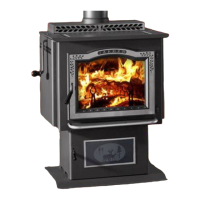6
Dry Seasoned Wood Only! Save These InstructionsHarman® • TL300 Owner's Manual_R25 • 2007 -___ • 08/15
B. Fire Safety
Maintain the designated clearances to combustibles.
Insulation must not touch the chimney. You must maintain
the designated air space around the chimney. This space
around a chimney is necessary to allow natural heat
removal from the area. Insulation in this space will cause
a heat buildup, which may ignite wood framing. NOTE:
Clearances may only be reduced by means approved
by the regulatory authority having jurisdiction.
To provide reasonable re safety, the following shouldbe
given serious consideration:
1. Installatleastonesmokedetectoroneachoorofyour
home. Detectors should be located away from the heating
appliance and close to sleeping areas. Follow the smoke
detector manufacturer's placement and installation
instructions, and be sure to maintain regularly.
2. A conveniently located Class A re extinguisher to
contendwithsmallresresultingfromburningembers.
3. A practiced evacuation plan, consisting of at least two
escape routes.
4. Aplantodealwithachimneyreasfollows:
Intheeventofachimneyre:
a. Evacuate the house immediately.
b. Notify Fire Department.
c. Never apply water to a suspected chimney re.
Serious damage could occur.
A. Design, Installation & Location Considerations
1. Appliance Location
Considerationmustbegiventosafety,convenience,trafc
ow,andthefactthattheappliancewillneedachimneyand
chimney connector. It is a good idea to plan your installation
on paper, using exact measurements for clearances and
oor protection, before actually beginning the installation.
When installing on a combustible oor, proper oor
protection material must be used. See page 12 for details.
Maintain specied vent clearance to combustible
requirements listed by the vent manufacturers instructions
and all clearance to combustibles listed in this manual.
Check with your local building code agency before you begin
your installation. Be sure local codes do not supersede UL
specications and always obtain the required permit so
thatinsuranceprotectionbenetscannotbeunexpectedly
cancelled. If any assistance is required during installation,
please contact your dealer.
Werecommendthataqualiedbuildinginspectorandyour
insurance company representative review your plans before
and after the installation.
Be sure to provide a source of fresh air to the room or
directly to the appliance. Make-up air is needed to replace
what the chimney draws away through the appliance.
Consider attaching outside air to the appliance. Certain
conditions can create negative pressure within the dwelling.
When this occurs, you may have trouble operating the wood
stove. Worse yet, it may be strong enough to allow smoke
leakage from the appliance. Installation on lower levels and
in basements can be especially affected.
3
Getting Started
DO NOT CONNECT THIS UNIT TO A CHIMNEY FLUE
SERVICING ANOTHER APPLIANCE.
DO NOT CONNECT TO ANY FORCED AIR DISTRIBUTION
DUCT OR SYSTEM.
CAUTION
FIRE HAZARD
DO NOT OPERATE APPLIANCE BEFORE
READING AND UNDERSTANDING THE
OPERATING INSTRUCTIONS.
FAILURE TO OPERATE PROPERLY MAY
CAUSE A HOUSE FIRE.
WARNING
Installation and service of this
appliance should be performed by
qualiedpersonnel.Hearth&Home
Technologies recommends HHT
Factory Trained or NFI Certied
professionals.

